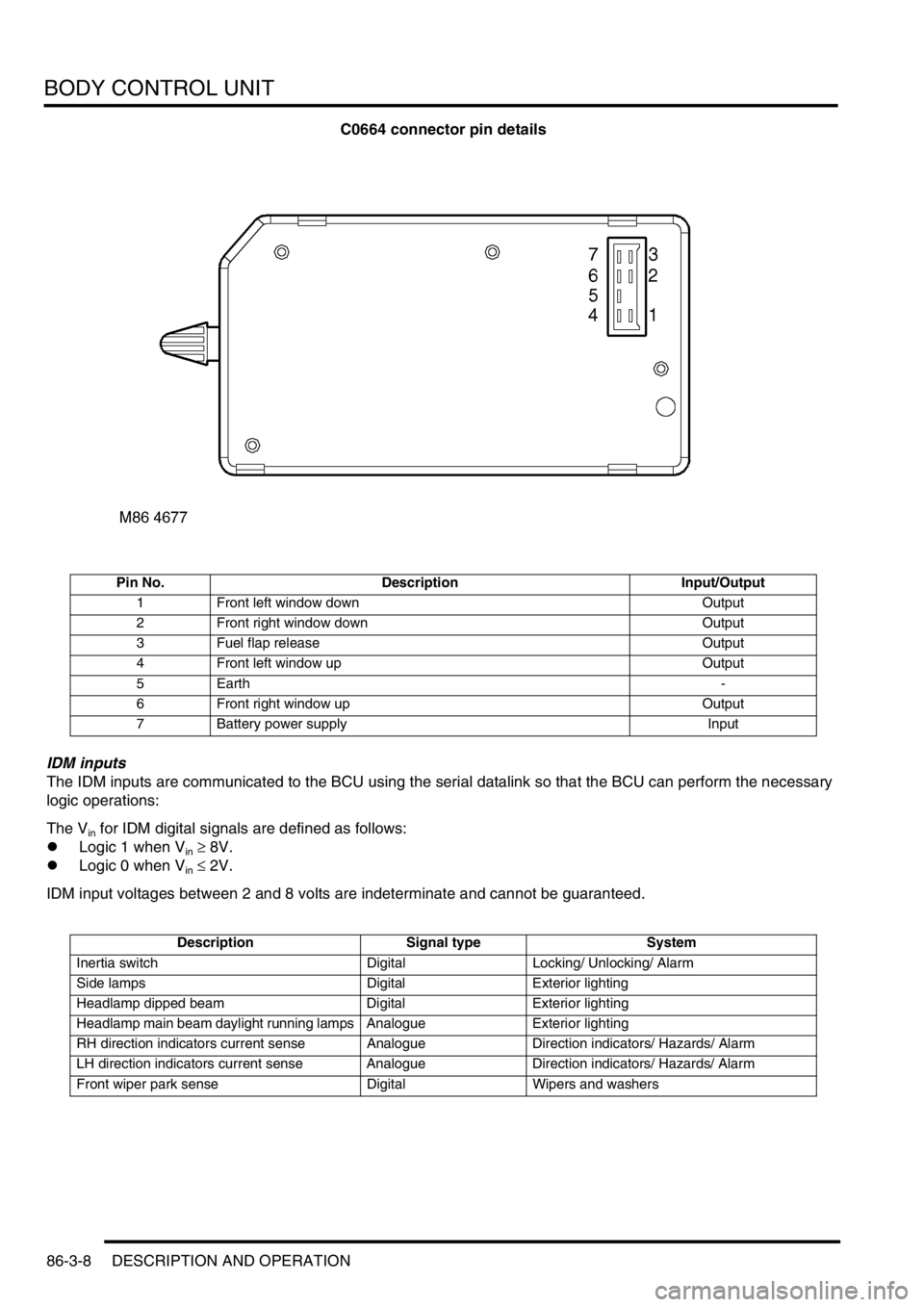2002 LAND ROVER DISCOVERY window
[x] Cancel search: windowPage 1477 of 1672

BODY CONTROL UNIT
86-3-8 DESCRIPTION AND OPERATION
C0664 connector pin details
IDM inputs
The IDM inputs are communicated to the BCU using the serial datalink so that the BCU can perform the necessary
logic operations:
The V
in for IDM digital signals are defined as follows:
lLogic 1 when V
in ≥ 8V.
lLogic 0 when V
in ≤ 2V.
IDM input voltages between 2 and 8 volts are indeterminate and cannot be guaranteed.
Pin No. Description Input/Output
1 Front left window down Output
2 Front right window down Output
3 Fuel flap release Output
4 Front left window up Output
5Earth-
6 Front right window up Output
7 Battery power supply Input
Description Signal type System
Inertia switch Digital Locking/ Unlocking/ Alarm
Side lamps Digital Exterior lighting
Headlamp dipped beam Digital Exterior lighting
Headlamp main beam daylight running lamps Analogue Exterior lighting
RH direction indicators current sense Analogue Direction indicators/ Hazards/ Alarm
LH direction indicators current sense Analogue Direction indicators/ Hazards/ Alarm
Front wiper park sense Digital Wipers and washers
Page 1478 of 1672

BODY CONTROL UNIT
DESCRIPTION AND OPERATION 86-3-9
IDM outputs
The IDM receives the following signals from the BCU using the serial datalink to provide power outputs:
Description Signal type System
Unlock all doors enable Digital Locking/ Unlocking/ Alarm
Lock passenger and rear doors enable Digital Locking/ Unlocking/ Alarm
Superlock all doors enable Digital Locking/ Unlocking/ Alarm
Lock driver's door Digital Locking/ Unlocking/ Alarm
Rear fog lamps enable Digital Exterior lighting
Daylight running lamps enable Digital Exterior lighting
LH direction indicators enable Digital Direction indicators/ Hazard warning/ Alarm
RH direction indicators enable Digital Direction indicators/ Hazard warning/ Alarm
Gear position indicator illumination Digital Illumination
Headlamp main beam indicator disable Digital Illumination
Front wiper enable Digital Wipers and washers
Rear wiper enable Digital Wipers and washers
Rear window enable Digital Power windows
Shift lever solenoid enable Digital Automatic gearbox
Transfer box solenoid enable/ Alarm sounder
relayDigital Gearbox
Heated rear window enable Digital Heated screens
Page 1480 of 1672

BODY CONTROL UNIT
DESCRIPTION AND OPERATION 86-3-11
Programmable options
The BCU can be programmed with a number of options to satisfy specific market requirements and customer
preferences. The options can be set using TestBook.
Function Option Details
Transmission Manual The vehicle is fitted with manual transmission.
Automatic The vehicle is fitted with automatic transmission.
Front fog lamps None The vehicle is not fitted with front fog lamps.
Main The front fog lamps will operate if the headlamps are on main
beam.
No main The front fog lamps will not operate if the headlamps are on main
beam.
Interlocks None The vehicle is not fitted with key, shift or transfer box interlocks.
Shift The vehicle is fitted with key, shift and transfer box interlocks.
No transfer The vehicle is fitted with key and shift interlocks, but not a transfer
box interlock.
Daylight running lamps None The vehicle is not fitted with daylight running lamps.
No main The daylight running lamps are on if the headlamp main beams
are off.
No heads The daylight running lights are on with headlamp main and dipped
beams off and the gearbox not in Park.
Programmed wash/ wipe Normal The front wipers operate if the front wash is operated.
No wipe The front wipers do not operate if the front wash is operated.
Key-in warning Disabled The ignition key in audible warning is disabled.
Enabled The ignition key in audible warning is generated if the ignition key
is in and the driver's door is open.
Electric front seats None The vehicle is not fitted with electric front seats.
Normal Electric seat adjustment is available for 45 seconds after the
driver's door opens or if the ignition is on.
Ignition II Electric seat adjustment is available if the ignition is on.
Electric front windows Driver cancel The front windows will be disabled 44 seconds after the driver's
door is opened.
All cancel The front windows will be disabled 44 seconds after any door is
opened.
No cancel The front windows will be disabled when the ignition is turned off.
Heated front screen Fitted The vehicle is fitted with heated front screens.
None The vehicle is not fitted with heated front screens.
Rear windows and
sunroofDriver cancel The rear windows and sunroof will be disabled 44 seconds after
the driver's door is opened.
All cancel The rear windows and sunroof will be disabled 44 seconds after
any door is opened.
No cancel The rear windows and sunroof will be disabled when the ignition
switch is turned off.
Gear position indicator
illuminationAlways The automatic gearbox selector illumination is on when the
ignition is on.
Sidelights The automatic gearbox selector illumination is on when the
ignition is on and the sidelights are off.
Hill descent control None The vehicle is not fitted with hill descent control.
Fitted The vehicle is fitted with hill descent control.
Courtesy headlamps Disabled The vehicle is not fitted with courtesy headlamps.
Enabled The vehicle is fitted with courtesy headlamps.
Odometer error warning Disabled The odometer will not flash if there is an odometer error.
Enabled The odometer will flash if there is an odometer error.
Page 1483 of 1672

BODY CONTROL UNIT
86-3-14 DESCRIPTION AND OPERATION
Alarm system
The alarm system comprises the following components:
lRF receiver.
lRF transmitter.
lBCU.
lIDM.
lDoor switches, door lock switches and bonnet switch.
lBattery backed-up sounder (BBUS).
lStatus LED.
On non NAS vehicles, power supply for the alarm sounder and the battery BBUS is provided through two relays in the
passenger compartment fuse box. Each of the coils of the alarm relays are directly connected to the IDM which
controls their operation under the direction of BCU signals received via the serial data bus.
On NAS vehicles, an audible warning is provided through operation of the vehicle horns. The BCU provides an earth
path for the coil of the horn relay to initiate vehicle horn operation.
+ ALARM SYSTEM AND HORN, DESCRIPTION AND OPERATION, Description.
Central Door Locking (CDL)
The BCU carries out the logic control operation for CDL. A CDL switch is mounted on the fascia panel and has two
inputs to the BCU, one for lock and one for unlock.
Door locking and unlocking can be performed using the remote transmitter in the keys and the receiver unit located
above the vehicle's headlining, behind the rear sunroof aperture. The receiver detects the signals sent from the
remote transmitter and sends a decoded signal to the BCU for processing.
Four methods of door locking are available:
lRemote handset locking.
lVehicle key locking.
lCDL switch locking.
lSpeed related locking.
Two security levels of door locking are available, CDL and Superlocking. The anti-theft alarm system works in
conjunction with the CDL system.
Electric windows and sunroof
The BCU controls the logical operations and the timing periods for the electric front windows. The rear windows are
hard-wired and the two electric sunroofs are controlled by a dedicated ECU which is enabled by the BCU.
The front windows are electrically operated using two rocker switches located in the centre console. Electric motors
are located in each of the front doors.
The rear windows are enabled by the IDM controlling the operation of the rear window relay located in the passenger
compartment fuse box.
Wipers and washers
The wiper and washer functions are controlled by the BCU and the IDM.
The front wipers and washers are operated from the switch stalk located on the right hand side of the steering column
and only operate when the ignition switch is in position I or II. The front wipers are operated by a motor located below
the windscreen plenum.
+ WIPERS AND WASHERS, DESCRIPTION AND OPERATION, Description.
Page 1487 of 1672

BODY CONTROL UNIT
86-3-18 DESCRIPTION AND OPERATION
Self levelling suspension and ABS
The BCU communicates with the SLABS ECU for several functions:
lAn output is provided from the SLABS ECU to the BCU to provide the logic conditions for issuing the SLS audible
warning.
lThe BCU receives an input from the SLABS ECU relating to the raise/ lower command from the remote handset.
+ REAR SUSPENSION, DESCRIPTION AND OPERATION, Description - SLS.
Hill descent control
The BCU provides an output signal to the SLABS ECU for automatic transmission in neutral for HDC control. The
BCU checks the status of the ignition and 'gearbox state' inputs and provides a 'Neutral selected' output. If the ignition
is on and 'gearbox state' is Neutral, the 'Neutral selected' output is on, otherwise 'Neutral selected' is off.
+ BRAKES, DESCRIPTION AND OPERATION, Description.
Heated screens
The Heated Front Screen (HFS) is fitted for some market destinations and is operated from a non-latching switch
located on the instrument pack cowl. The BCU will only allow the heated front screen to operate when the engine is
running and controls the time-out period for switching the circuit off.
The heated front screen operation can also be controlled from the Automatic Temperature Control (ATC) ECU on
vehicles fitted with air conditioning.
The heated rear window will only function when the engine is running, and is operated by a non-latching switch on the
instrument pack cowl. The heated rear window can also be operated by the ATC ECU on vehicles fitted with air
conditioning.
Interior courtesy lamps
The BCU controls the operation of the interior courtesy lamps. The courtesy lamps are situated in the front, mid and
rear areas of the headlining.
Fuel flap actuator
The BCU provides an earth path to the fuel flap release solenoid to allow the fuel filler flap to be opened. This is only
allowed if the alarm system is not set and all other conditions have been satisfied. The fuel flap release switch is
located in the fascia switch pack and it receives a voltage supply from the passenger compartment fuse box.
Audible warnings
The BCU can request the instrument pack to generate an audible warning in response to conditions it has detected
and which need to be drawn to the driver's attention. One of six different audible warnings can be requested by the
BCU.
Sound request number Sound functions Priority (1 = lowest, 6 = highest)
0Off 1
1 Seat belt warning 6
2 Key-in warning 3
3 SLABS/ HDC warning 4
4 Transfer box in neutral warning 5
5 Lights on warning 2
Page 1488 of 1672

BODY CONTROL UNIT
DESCRIPTION AND OPERATION 86-3-19
Operation
For IDM inputs which are also inputs for BCU functions, the delay before the BCU recognises the change in input
status is less than 250 ms. The BCU uses a debounce algorithm to ignore changes in input having a duration less
than 100 ms with the exception of automatic gearbox W, X, Y, Z inputs, which have a debounce period of 33 ms.
Transit mode
To prevent excessive battery drain during transit to overseas markets, the vehicle is placed in a transit mode.
To exit the transit mode, simultaneously hold down the heated rear window switch and the rear fog lamp switch, turn
the ignition switch from 0 to II and, after a minimum of 2 seconds, release the switches.
Transit mode can be entered using TestBook. When TestBook communicates with the BCU for diagnostics related to
BCU operation, it first checks that the vehicle is not in transit mode.
Anti-theft system
The BCU uses the driver's door key lock and unlock switches to activate and deactivate the security system. The
driver's door lock is also used for entering the EKA.
+ ALARM SYSTEM AND HORN, DESCRIPTION AND OPERATION, Description.
Immobilisation
For immobilisation, the BCU disables the starter motor relay. When the engine is cranking, the ECM looks for a coded
signal from the BCU. If the signal is not received within one second of cranking, the fuel supply to the engine is
stopped and the injectors are disabled. This also prevents unburnt fuel from entering the catalyst.
If the BCU is disconnected, the engine starter motor will remain isolated by the starter motor relay and the ECM will
remain immobilised. The main wiring for the system is contained within the main harness which is relatively
inaccessible, so preventing intruders from disabling the system by cutting the wires for the immobilisation system.
Once the immobiliser has been activated, destruction of the trigger device or the wiring to it will not disarm the system.
The RF transmitter communicates to the BCU via the RF receiver using a 70 bit code. Pressing the unlock button on
the transmitter will re-mobilise the vehicle. The RF transponder is integrated into the metal key assembly, inserting
the key into the ignition switch will induce a signal in the exciter coil to re-mobilise the vehicle.
Anti-theft alarm
The alarm system provides a warning of unauthorised access to the vehicle and includes perimetric and volumetric
monitoring under the control of the BCU.
The perimetric protection system detects opening of all doors, tail door and bonnet and will also detect the operation
of the ignition key switch. The following conditions must be satisfied before the BCU will operate all of the functions
of perimetric protection:
lAll doors and hinged panels are in the closed position.
lIgnition key out of the ignition switch.
lInertia switch is not tripped.
If all conditions are not satisfied the BCU will enter a mislock condition.
The volumetric sensor uses two ultrasonic sensors mounted in the headlining to detect movement within the vehicle.
The alarm will trigger when the sensor signals the BCU for 200 ms or greater. Within a single setting period the alarm
system will allow a maximum of 10 triggers as a result of any combination of sensor inputs. It is possible to lock the
vehicle without enabling the volumetric alarm by using the key. The same conditions needed to satisfy enabling of the
perimetric protection system is also needed to enable volumetric protection.
Page 1491 of 1672

BODY CONTROL UNIT
86-3-22 DESCRIPTION AND OPERATION
The following outputs are generated by the BCU dependent on the prevailing logic conditions and the input requests
the BCU has detected:
lUnlock all doors enable.
lLock passenger and rear doors enable.
lSuperlock all doors enable.
lLock driver's door enable.
All lock/ unlock pulses have a duration of 800 ms.
Input/Output logic for door lock/unlock
To determine if the vehicle speed is appropriate for enabling speed related locking, the BCU uses the vehicle speed
signal supplied over the serial data bus from the instrument pack.
Electric windows and sunroof
Three modes of operation are available:
lDriver cancel – the front windows, rear windows and sunroof will be disabled 44 seconds after the driver's door
is opened.
lAll cancel – The front windows, rear windows and sunroof will be disabled 44 seconds after any door is opened.
lNo cancel – the front windows, rear windows and sunroof will be disabled when the ignition is turned off.
The BCU will allow window and sunroof operation when the ignition key is in position II. The BCU provides a voltage
to the window control switches. When the switches are pressed, they provide a path to earth to complete the circuit
and initiate window operation. Window and sunroof operation is suspended when the ignition switch is in the crank
position.
For front window operation, the BCU checks the status of the following inputs:
lIgnition state.
lDriver's door open.
lPassenger or rear door open.
lFront right window down.
lFront right window up.
lFront left window down.
lFront left window up.
lRight window stall detect.
lLeft window stall detect.
The front window motors are directly connected to the BCU by two wires. Each wire can be used as a feed or return,
dependent on the required direction for motor operation (open or close). The BCU provides the following outputs:
lRight window up.
lRight window down.
lLeft window up.
lLeft window down.
The electric front windows are enabled when the ignition switch is in position II and is disabled if the ignition switch is
moved to the crank position.
Output/Request Superlock all
doors enableUnlock all doors
enableLock driver's
door enableLock passenger
and rear doors
enable
Unlock request 0100
Lock request 0011
Superlock request 1011
Single point entry request 0101
Lock passenger and rear doors
request0001
Page 1492 of 1672

BODY CONTROL UNIT
DESCRIPTION AND OPERATION 86-3-23
The BCU checks the status of the following inputs to determine when to provide the rear window enable and sunroof
enable output signals:
lIgnition state.
lDriver's door open.
lPassenger or rear door open.
The rear window enable and sunroof enable lines are on when the ignition switch is in position II, and are switched
off if the ignition switch is moved to the crank position.
The BCU monitors the circuit current draw when the windows are operating to detect the occurrence of a stall
condition. If the BCU determines that the window has stalled, it will cut the power supply to stop the operation of the
window motor. The BCU only starts to check for a stall condition after the window has been operating for 500 ms. This
delay period enables the initial current surge to pass and eliminates false detections of window stall. A stall condition
is activated when a nominal current value is exceeded for a period greater than 300 ms.
If the BCU detects that it has been operating the same window motor in one direction for more than 10
± 0.2 seconds,
without the BCU detecting a stall condition or the control switch being released, it will automatically stop operation of
the window motor (timed out). Window operation can resume when the window switch is released and pressed again.
If the window was operating in one touch mode, the window operation will resume on the next press of the window
switch.
One touch mode automatically lowers the window to its fully open position, without the need for the window switch to
be kept pressed for the duration of the window travel. One touch mode is initialised if the window switch is pressed
for a period of less than 0.4
± 0.2 second. One touch mode continues to lower the window until the BCU detects:
lA stall condition exists (window has reached bottom of travel).
lWindow switch is repressed in either direction for more than 0.4
± 0.2 second.
lThe BCU has operated the motor for a period greater than 10
± 0.2 seconds.
A timeout function is included which allows the windows and sunroofs to be operated for a period of 44
± 1 seconds
after the ignition key has been removed from the ignition switch. The timeout function will be cancelled if the BCU
detects the following conditions:
lThe driver's door has been closed after the ignition has been switched off.
lAny door open after the ignition is switched off.
The preconditions are programmed into the BCU dependent on market specification.
The BCU does not directly control rear window operation, but it can request the IDM to remove the power feed to the
rear windows. The IDM enables power supply to be provided to the rear lift relay in the passenger fuse box. When the
relay coil is energised the relay contacts close and power is applied to the rear window motor. If the window lift
isolation switch located in the centre console is latched out, the earth path from the LH and RH rear door window
switches is broken and operation of the rear window motors through the use of the rear window switches is prevented.
Rear window operation using the console switches is not affected by the isolation switch.
In the event of a communications link failure occurring while rear window enable is on, the relay remains on until the
ignition switch is turned to the off position.